Welcome to MAE 87 Freshman Seminar
New Observations
and Ideas about Cosmology
Winter Quarter: Jan. 5 to Mar. 2, 2005
EBU2 room 479, 10 to 11:50
Course outline
 EBU2: 479 is on the fourth floor facing the
main UCSD campus library (West).
EBU2: 479 is on the fourth floor facing the
main UCSD campus library (West).
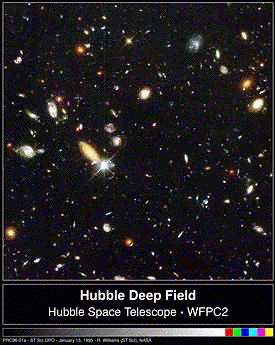
This image taken with the Hubble Space Telescope shows galaxies
of stars in a small dark part of the Big Dipper. Because it is
dark we know the age of the universe is finite. Because all the
galaxies are moving away and because the view is the same in all
directions, most scientists believe they all started at once about
13 billion years ago with a big bang.
Most of the matter (99.9%) in this image is not in the form
of luminous stars, and is therefore termed "dark matter".
The percentage is a subject of debate, as is the form of the dark
matter. Even the big bang origin of the universe is debatable.
One purpose of the class is to urge students to keep their minds
open to new ideas about cosmology. Information is flooding in
at a rate never before seen in astronomy. Old ideas are evaporating
faster than new ideas can form to replace them. Another purpose
of the class is to alert students to sources of the new information
and ideas about astronomy and to give them some tools needed to
appreciate the significance of the information as it arrives.
First tool: Don't believe everything people
say. Second tool: Listen anyway.
Look through the HST webpages carefully to see the range
of new information available from that source alone, but be skeptical
about the explanations. Notice that the first images from HST
began arriving in 1994, when the revolution in astronomy and cosmology
began.

This is the Hubble Space Telescope (HST). It was placed into
orbit 380 miles above the earth in 1990. Remarkably, its pictures
are available almost immediately to everyone through the internet,
and a fabulous archive of these pictures is maintained.
 SIRTF
Space Infrared Telescope Facility Launched August 25, 2003
SIRTF
Space Infrared Telescope Facility Launched August 25, 2003
This telescope promises to give much new information about
objects that are cooler than stars like large planets. The telescope
is in a three month check-out period now, but clearly is working
well as shown by the engineering image below.
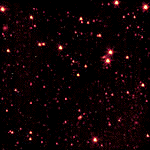 This engineering image is a quick
look at the sky through the Infrared Array Camera (IRAC), one
of three scientific instruments aboard SIRTF. The 5 arcmin x 5
arcmin image was taken in a low Galactic latitude region in the
constellation Perseus. It results from 100 seconds of exposure
time with the short-wavelength (3.6 micron) array. The visible
band is at about 0.5 micron wavelength, so this view would be
quite invisible to the naked eye of humans.
This engineering image is a quick
look at the sky through the Infrared Array Camera (IRAC), one
of three scientific instruments aboard SIRTF. The 5 arcmin x 5
arcmin image was taken in a low Galactic latitude region in the
constellation Perseus. It results from 100 seconds of exposure
time with the short-wavelength (3.6 micron) array. The visible
band is at about 0.5 micron wavelength, so this view would be
quite invisible to the naked eye of humans.
 National Aeronautics and Space
Administration (NASA) "Origins"
program
National Aeronautics and Space
Administration (NASA) "Origins"
program
Look through these pages to see the conventional wisdom about
the origins of the universe and its components. Many of the assumptions
are questionable, and will be discussed in class. Gives a good
summary of our present space program in astronomy and astrophysics.
Other telescopes investigate the ultraviolet and X-ray bands,
which generally originate from superhot objects like black hole
accretion disks and quasars. Gamma rays appear in random directions
as localized bursts. Many theories have been advanced to explain
this phenomenon, but no concensus has emerged about the correct
explanation except that "gamma-ray bursts" must come
from outside our Milky Way galaxy.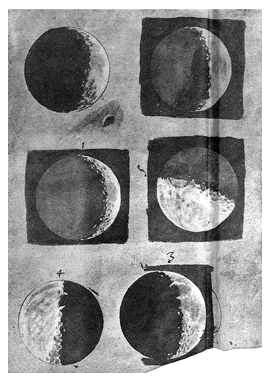
The first observations by telescope were by Galileo in 1609.
The sketches were made in ink from his observations of the moon,
and clearly showed the moon was not smooth as previously thought.
Galileo also saw four of the moons of Jupiter with his telescope.
The Next Generation Space Telescope (NGST) will be larger than
the HST and have better infrared sensitivity to see back further
in time toward the big bang. The launch date is 2008, nearly 400
years after Galileo's pioneering sketches.
The most distant and earliest information comes to us with
red-shift of more than 1000 in the microwave frequency band. By
a trick of general relativity theory the big bang does not appear
as a distant point in some particular direction, but as a sphere
stretched uniformly about us. The "cosmic
microwave background radiation" (CMB-Wayne Hu website)
is also a surrounding sphere reflecting the universe at a time
about 300,000 years after the big bang at the time when the opaque
primordial plasma of hydrogen and helium cooled enough so that
it turned into a transparent gas.
A huge effort has been expended to study the CMBR
in detail, since this is the earliest data available about
the universe. Telescopes have been attached to balloons to avoid
the absorption of microwave radiation by the atmosphere, and another
(WMAP) has been
in orbit for nearly two years about the neutral point beyond the
earth where gravity and centrifugal forces balance for the earth-sun
system (the second Lagrange point).
One result of this effort is evidence that the big bang is
the result of a period of strong turbulence. The evidence is circumstantial.
Turbulence causes very special
statistical patterns in quantities the turbulence mixes, like
temperature. The temperature patterns of the CMB precisely match
the patterns that occur for strong turbulence. The question is,
"When was the universe before 300,000 years turbulent?".
The answer appears to be that it was turbulent from the beginning.
You will not find much information about turbulence in cosmology
if you search the literature. One reason is that turbulence was
claimed to be important by early cosmologists such as George Gamov
in ways that have been shown to be unlikely by modern observations.
Gamov thought primordial turbulence caused galaxies to precipitate
on the density maxima produced by the turbulence. However, the
CMB observations show the primordial universe was much too uniform
to be turbulent; that is, the temperature fluctuations were only
1/100,000 compared to 1/10 expected for turbulence. This just
means that the universe was not turbulent at the time of the CMB,
not that the universe was never turbulent. The most important
question is, "Why was the universe at the time of the CMB
not turbulent?". Fluids in motion at large scales tend to
become turbulent unless something prevents the turbulence from
forming, such as viscosity (molasses), buoyancy forces (the ocean
and atmosphere) or strong rotation (Jupiter). It turns out that
all of these factors probably acted to inhibit turbulence at various
stages in the fluid
mechanical history of the universe. At the time of the CMB
(300,000 years after the big bang beginning) the only forces available
to prevent turbulence were viscous forces and buoyancy forces.
The viscosity required is enormous (10^30 m^2 s^-1) compared to
that of the plasma (10^25 m^2 s^-1) so we are left only with buoyancy
forces, but this means gravitational structure formation must
have begun in the primordial plasma. When did this happen? All
evidence points to a time about 30,000 years after the big bang
when the mass of the matter within the scale of causal connection
ct matched the known mass of superclusters of galaxies 10^47 kg,
where c is light speed and t is time. These large structures fragmented
to galaxy masses of 10^43 kg before turning to gas.
B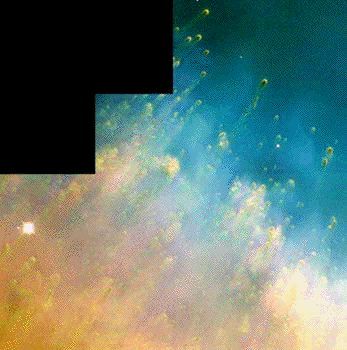 ecause the time, temperature,
density, composition, and rate-of-strain of the cooling plasma
at its transition to gas are all precisely known, the
fluid mechanics of gravitational structure formation when the
plasma universe turned to gas is easy. The gas was unstable
to fragmentation at two length scales, one determined by the speed
of sound and one determined by the viscosity. The viscosity of
the H-He gas reduced by a trillion from that of the plasma so
the gravitational fragmentation mass became that of a small planet
(10^25 kg). The sound speed reduced from c/3^.5 for the plasma
(2x10^8 m/s) to < 10^5 m/s so the acoustic fragmentation mass
became that of a globular cluster of stars (10^36 kg). Within
a gravitational free-fall time of less than a million years after
the plasma-gas transition at 300,000 years the plasma turned to
a fog of earth-mass fragments within million-sun mass clumps,
within trillion-sun mass proto-galaxies...and stars appeared.
The baryonic dark matter consists of proto-globular-star-cluster
clumps (PGCs) of primordial-fog-particles (PFPs) that have frozen
to form Jovian (ie: like Jupiter...gassy vs. rocky) planets rather
than merging to form stars. These Earth-mass Jovian planets dominate
the density of the interstellar medium. They are revealed only
if something very hot appears in their near vicinity to cause
their frozen hydrogen and helium gasses to evaporate. This occurs
in planetary nebula, which are solar mass dying stars that become
very hot when they have nothing left but carbon, which crushes
itself to become a white dwarf star. An example is the Helix planetary
nebula, the closest one to the earth. With the Hubble Space Telescope
we see it is surrounded by thousands of "cometary globules",
which are likely these primordial-fog-particle (PFP) Jovian planets
coming out of cold storage. Each of the comets is 10^13 m in diameter,
the size of the solar system out to Pluto.
For details, see the HST archives. The comets (PFPs) are separated
by about 10^14 m, and weigh 10^24
to 10^25 kg (some of the ones close to the hot star are much
heavier, say 10^27 kg like Jupiter because they are ancient aggregates
of thousands of the smaller PFPs). Stars are formed by gravitational
accretion of millions of PFPs forming thousands of such Jupiters
that form hundreds of brown dwarfs, etc.
ecause the time, temperature,
density, composition, and rate-of-strain of the cooling plasma
at its transition to gas are all precisely known, the
fluid mechanics of gravitational structure formation when the
plasma universe turned to gas is easy. The gas was unstable
to fragmentation at two length scales, one determined by the speed
of sound and one determined by the viscosity. The viscosity of
the H-He gas reduced by a trillion from that of the plasma so
the gravitational fragmentation mass became that of a small planet
(10^25 kg). The sound speed reduced from c/3^.5 for the plasma
(2x10^8 m/s) to < 10^5 m/s so the acoustic fragmentation mass
became that of a globular cluster of stars (10^36 kg). Within
a gravitational free-fall time of less than a million years after
the plasma-gas transition at 300,000 years the plasma turned to
a fog of earth-mass fragments within million-sun mass clumps,
within trillion-sun mass proto-galaxies...and stars appeared.
The baryonic dark matter consists of proto-globular-star-cluster
clumps (PGCs) of primordial-fog-particles (PFPs) that have frozen
to form Jovian (ie: like Jupiter...gassy vs. rocky) planets rather
than merging to form stars. These Earth-mass Jovian planets dominate
the density of the interstellar medium. They are revealed only
if something very hot appears in their near vicinity to cause
their frozen hydrogen and helium gasses to evaporate. This occurs
in planetary nebula, which are solar mass dying stars that become
very hot when they have nothing left but carbon, which crushes
itself to become a white dwarf star. An example is the Helix planetary
nebula, the closest one to the earth. With the Hubble Space Telescope
we see it is surrounded by thousands of "cometary globules",
which are likely these primordial-fog-particle (PFP) Jovian planets
coming out of cold storage. Each of the comets is 10^13 m in diameter,
the size of the solar system out to Pluto.
For details, see the HST archives. The comets (PFPs) are separated
by about 10^14 m, and weigh 10^24
to 10^25 kg (some of the ones close to the hot star are much
heavier, say 10^27 kg like Jupiter because they are ancient aggregates
of thousands of the smaller PFPs). Stars are formed by gravitational
accretion of millions of PFPs forming thousands of such Jupiters
that form hundreds of brown dwarfs, etc.
Not all of the big-bang matter could turn into gas....only
the hydrogen and helium. The remainder is called the "non-baryonic
dark matter" and is probably something like neutrinos or
is an unfamiliar neutrino species. Neutrino species were formed
in vast quantities during the hot stages after the big bang when
the protons and neutrons of the hydrogen and helium atoms were
formed, and only recently (1998) have been discovered to have
mass. Neutrino-species are difficult to study because they interact
very weakly with other particles and are formed at temperatures
too hot to produce on Earth. Gravitational fragmentation of the
"neutrino-fluid" was much later than the fragmentation
of the plasma and gas of baryons because it is so diffusive. Neutrino-fluid
forms outer halos of galaxies and galaxy clusters in fluid-cosmology
modeling. The total mass of the neutrino-fluid halos of galaxies
is about 30 times larger than that of the stars or dark-matter
PFPs that form the inner galaxy halos, but its density is less.
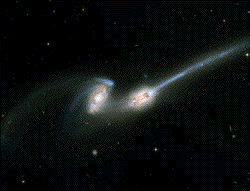 Strange pictures emerge from
the HST archives such as this picture of two merging galaxies
called the Mice because of the star tails. We will see that the
standard explanations of such galaxies in terms of collisionless
interactions and tidal ejections of the stars along the tails
have difficulties when confronted with high resolution images
that show young globular clusters (YGCs) and new stars forming
along the tails. The ages of the YGCs are smaller than the time
it takes to form the tail, so they must be formed in place. Where
do they get the matter for their million stars, and how is it
concentrated to densities millions of times larger than the ambient
density? The answer is that the matter was dark (PFPs in PGCs)
before the galaxy passage and the star and star-cluster formation
was triggered due to agitations of the dark matter caused by the
passage of the galaxy. As the merging galaxies pass through each
other's inner halos, the PFP planets are evaporated and their
accretion rate increases. The new stars and new globular clusters
of stars appear as luminous wakes of the passing galaxies. Only
the inner dark-matter halos of the two galaxies are included in
this picture (3 10^21 m)...the outer neutrino-fluid halos are
much larger (3 10^22 m).
Strange pictures emerge from
the HST archives such as this picture of two merging galaxies
called the Mice because of the star tails. We will see that the
standard explanations of such galaxies in terms of collisionless
interactions and tidal ejections of the stars along the tails
have difficulties when confronted with high resolution images
that show young globular clusters (YGCs) and new stars forming
along the tails. The ages of the YGCs are smaller than the time
it takes to form the tail, so they must be formed in place. Where
do they get the matter for their million stars, and how is it
concentrated to densities millions of times larger than the ambient
density? The answer is that the matter was dark (PFPs in PGCs)
before the galaxy passage and the star and star-cluster formation
was triggered due to agitations of the dark matter caused by the
passage of the galaxy. As the merging galaxies pass through each
other's inner halos, the PFP planets are evaporated and their
accretion rate increases. The new stars and new globular clusters
of stars appear as luminous wakes of the passing galaxies. Only
the inner dark-matter halos of the two galaxies are included in
this picture (3 10^21 m)...the outer neutrino-fluid halos are
much larger (3 10^22 m).
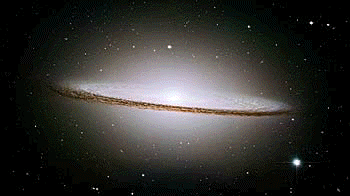 Have a look at the recent HST
composite image of the Sombrero
galaxy. The bright objects are not stars but globular clusters
of stars...thousands of them out of the million protogalaxy original
supply of dark PGCs (there is a bright foreground star at 4 o'clock
and a double
galaxy at 7 o'clock). Stars look like smoke at these distances,
even to the HST. The Milky Way galaxy only has a couple of hundred
luminous globular clusters from its PGC supply. Sombrero's black
hole is a thousand times larger than the million sun black hole
in Milky Way. The larger luminous "core" of field stars
for Sombrero is apparently related to the black hole formation
process. Like the Milky Way, all the globular star clusters in
Sombrero are very old...13 billion years, not like in Mice where
they are young...only a million.
Have a look at the recent HST
composite image of the Sombrero
galaxy. The bright objects are not stars but globular clusters
of stars...thousands of them out of the million protogalaxy original
supply of dark PGCs (there is a bright foreground star at 4 o'clock
and a double
galaxy at 7 o'clock). Stars look like smoke at these distances,
even to the HST. The Milky Way galaxy only has a couple of hundred
luminous globular clusters from its PGC supply. Sombrero's black
hole is a thousand times larger than the million sun black hole
in Milky Way. The larger luminous "core" of field stars
for Sombrero is apparently related to the black hole formation
process. Like the Milky Way, all the globular star clusters in
Sombrero are very old...13 billion years, not like in Mice where
they are young...only a million.
 Picture
of the week. See the pictures NASA scientists found most interesting
during 2003. Read the explanations, but don't believe everything
you read (for example, ignore everything about cold dark matter,
dark energy, dark halos, the accelerating universe and dark ages).
If you want more, see the Astronomy
picture of the day.
Picture
of the week. See the pictures NASA scientists found most interesting
during 2003. Read the explanations, but don't believe everything
you read (for example, ignore everything about cold dark matter,
dark energy, dark halos, the accelerating universe and dark ages).
If you want more, see the Astronomy
picture of the day.
 Nova programs (3 hours) about string
theory, a complex 11 dimensional description that may help
resolve the failures of general relativity theory and quantum
mechanics in a new theory of everything.
Nova programs (3 hours) about string
theory, a complex 11 dimensional description that may help
resolve the failures of general relativity theory and quantum
mechanics in a new theory of everything.
Last edited: Dec. 30, 2004
